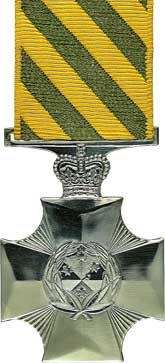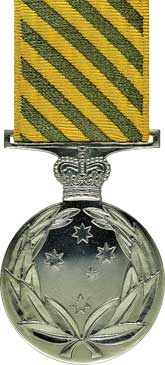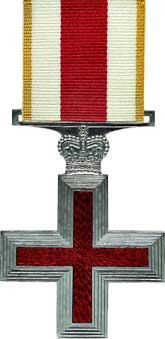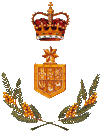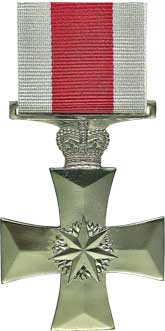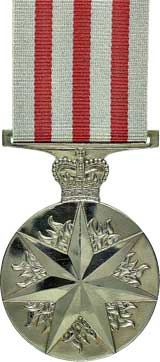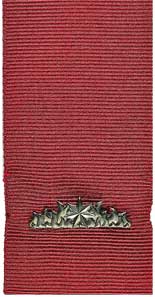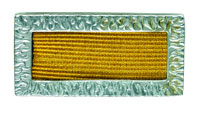From the earliest times countries have rewarded excellence, achievement and outstanding service. This recognition has taken many forms, including gifts of property, the granting of titles and the awarding of medals.
The purpose of Defence honours and awards is to recognise the service of members of the Australian Defence Force.
Distinguished Service
|
Conspicuous Service Cross
The Conspicuous Service Cross (CSC) was introduced in 1989 to recognize outstanding devotion to duty, or outstanding achievement in the application of exceptional skills, judgment or dedication, in non-warlike situations.
Insignia
The CSC is a nickel-silver modified Maltese cross with the arms of the Cross interspersed with fluted rays. The obverse bears a central device of the Southern Cross surrounded by a laurel wreath. The reverse has a horizontal panel for recipient details.
Ribbon
The CSC ribbon has alternating diagonal stripes of bush green and sandy gold.
Further Awards
A further award of the CSC is denoted by a nickel-silver bar with a central replica of the Cross flanked by laurel leaves. When the ribbon is worn alone, the award of a bar is indicated by a ribbon bar emblem in the form of the Cross.
Postnominal
Recipients of the Conspicuous Service Cross are entitled to the postnominal letters ‘CSC’. Recipients of a bar to the CSC add ‘and Bar’ to the postnominal.
Back to Top |
|
Conspicuous Service Medal
The Conspicuous Service Medal (CSM) was introduced in1989 to recognize meritorious achievement or devotion to duty in non-warlike situations.
Medal
The CSM is a nickel-silver medal with the obverse having a central device of the Southern Cross surrounded by a laurel wreath. The reverse has a horizontal panel for recipient details over a design of fluted rays.
Ribbon
The CSM ribbon has alternating narrow diagonal stripes of bush green and sandy gold.
Further Awards
A further award of the CSM is denoted by a nickel-silver bar with a superimposed central replica of the Medal flanked by laurel leaves. When the ribbon is worn alone, the award of a bar is indicated by the addition of a ribbon bar emblem in the form of the Medal.
Postnominal
Recipients of the Conspicuous Service Medal are entitled to the postnominal letters ‘CSM’. Recipients of a bar to the CSM add ‘and Bar’ to the postnominal
Back to Top |
|
Nursing Service Cross
In the Imperial system, members of the nursing services of the defence forces were eligible for the award of the two grades of the Royal Red Cross. This was introduced by Queen Victoria in 1883 and was awarded to recognize special devotion and competence in nursing duties.
The Nursing Service Cross (NSC) was introduced in 1989 and is awarded for outstanding devotion and competence in the performance of nursing duties, or for an act of exceptional dedication in the performance of such duties. It may be awarded in both warlike and non-warlike situations.
Insignia
The NSC is a four-stepped sterling silver straight armed cross. The obverse has a transparent red enamel cross insert on each axis, on a flecked pattern radiating from the centre of the medal. The reverse has a horizontal panel for recipient details superimposed on a design of fluted rays of varying lengths.
Ribbon
The NSC ribbon has a central red vertical stripe flanked by two white stripes and edged with gold stripes.
Further Awards
A further award of the NSC is denoted by a sterling silver bar with superimposed red enamel cross. When the ribbon is worn alone the award of a bar is indicated by a ribbon bar emblem in the form of a cross of red enamel.
Postnominal
Recipients of the Nursing Service Cross are entitled to the postnominal letters ‘NSC’. Recipients of a bar to the NSC add ‘and Bar’ to the postnominal.
Back to Top |
Distinguished Service
|
Distinguished Service Cross
The Distinguished Service Cross (DSC) was introduced in 1991 and is awarded for distinguished command and leadership in action. As with gallantry decorations, distinguished service decorations are not specific to rank, but because the DSC is for “command” in action, it is more likely that the DSC will be awarded to officers.
Insignia
The DSC is a modified Maltese Cross of nickel-silver with the obverse having a central device of the Federation Star on a disc of flames. The reverse has a panel for recipient details.
Ribbon
The DSC ribbon has a central stripe of ochre-red flanked by silver-blue stripes.
Further Awards
A further award of the DSC is denoted by a nickel-silver bar with the Federation Star superimposed on a horizontal row of flames. When the ribbon is worn alone, the award of a bar is indicated by the addition of a ribbon bar emblem in the form of a nickel-silver Federation Star.
Postnominal
Recipients of the Distinguished Service Cross are entitled to the postnominal letters ‘DSC’. Recipients of a bar to the DSC add ‘and Bar’ to the postnominal. |
|
Distinguished Service Medal
The Distinguished Service Medal (DSM) was introduced in 1991 and is awarded for distinguished leadership in action.
Medal
The DSM is a nickel-silver medal with a Federation Star on a circle of flames on the obverse. The reverse has a panel for recipient detail over a design of fluted rays of varying lengths.
Ribbon
The DSM ribbon has alternating stripes of silver-blue and ochre-red.
Further Awards
A further award of the DSM is denoted by a nickel- silver bar with the Federation Star on a horizontal row of flames. When the ribbon is worn alone, the award of a bar is indicated by a ribbon bar emblem in the form of a Federation Star on a nickel-silver disc.
Postnominal
Recipients of the Distinguished Service Medal are entitled to the postnominal letters ‘DSM’. Recipients of a bar to the DSM add ‘and Bar’ to the postnominal. |
|
Commendation for Distinguished Service
The Commendation for Distinguished Service was introduced in 1991 and is awarded for distinguished performance of duties in warlike operations.
Insignia
The insignia of the Commendation for Distinguished Service is nickel-silver with a Federation Star superimposed on a row of flames.
Ribbon
The Commendation for Distinguished Service insignia is mounted on a plain ochre-red ribbon. A miniature insignia is worn on the ribbon bar.
Further Awards
Further awards of the Commendation for Distinguished Service are made by Warrant describing the separate action being recognised. No additional insignia is received or worn.
Postnominal
There is no entitlement to postnominal letters for recipients of the Commendation for Distinguished Service.
Administration
Back to Top |
Order of Australia (Military Division)
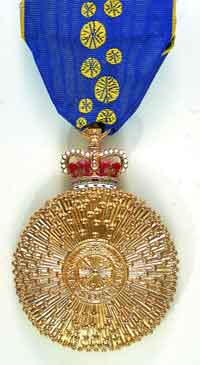 |
The Order of Australia was instituted with both a General Division and a Military Division. The two divisions are distinguished by a different ribbon.
All classes of the order (Companion, Officer, Member and Medal of the Order) are available in both divisions. The eligibility criteria for the equivalent classes in the two divisions require similar levels of achievement, but those for the Military Division are designed to reflect military service.
An individual may hold awards in both divisions and is entitled to wear the insignia of both. Appointments in the General Division take precedence over the equivalent appointment in the Military Division.
Insignia
The insignia of the order is a single flower head of mimosa, in the form of a convex disc. This provides the basic design for the insignia of all grades and the medal of the order, including lapel pins. There is no distinction between the insignia of the General or Military Divisions.
Ribbon
The ribbon is royal blue with a central band of scattered gold mimosa. The ribbon of the Military Division is of the same design but edged with gold bands 1.5 mm wide. The ribbon colours reflect the national colours of Australia at the time the order was established.
Postnominal
Persons appointed to the Order of Australia are entitled to the postnominal letters ‘AC’, ‘AO’, ‘AM’ or ‘OAM’ according to the level of the appointment. ‘(Mil)’ may be added to distinguish an appointment in the Military Division by those who also hold an appointment in General Division.
Back to Top |
Unit Commendations
| |
Unit Citation for Gallantry |
|
Meritorious Unit Citation |
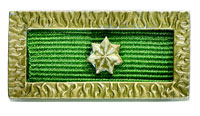
|
The Imperial system recognized individuals and made no provision to recognize gallant or distinguished service by entire units. The ADF has however received a number of unit awards from foreign nations. Recognizing the value of unit awards, two Australian unit awards were introduced in 1991 - the Unit Citation for Gallantry and the Meritorious Unit Citation.
The Unit Citation for Gallantry is awarded to a unit for extraordinary gallantry in action. The Meritorious Unit Citation is awarded to a unit for sustained outstanding service in warlike operations.
Insignia
The actual citation is a warrant presented to the unit. Insignia are worn by individuals to denote their membership of a unit that has been awarded a citation. Personnel cannot be issued with the insignia until the authorised unit representative, normally the CO, has been formally invested with the citation.
The insignia of a Unit Citation for Gallantry is a gilt rectangular frame surrounding a deep green ribbon. The frame has a design of flames emanating from the outer edges of the frame to the centre.
The insignia of a Meritorious Unit Citation is a rhodium-plated rectangular frame of the same dimensions and design surrounding a ribbon of old-gold.
Personnel who were members of the unit when an award was made wear a Federation Star in the centre of the ribbon and continue to wear the insignia after leaving the unit. Personnel who are subsequently posted to the unit wear the insignia without the Federation Star and only while actually posted to the unit.
Further Awards
Further awards of the Unit Citation for Gallantry or the Meritorious Unit Citation are recognized by the presentation of a further Certificate of Citation to the unit signed by the Governor-General. Only one insignia of each citation may be worn by a member of the unit. Only one Federation Star device is worn, irrespective of the number of awards made to units to which a member may be posted.
Back to Top |
Courtesy of Australian Defence Honours and Awards
